Best Way to Build Patio Attached to House
Patio Comprehend Plans
These patio encompass plans describe how I built my ain patio encompass. There are many ways to build a patio encompass; every situation is unlike. These plans are intended to provide you with some useful insight, while you are designing and building a patio comprehend for your own abode.
Patio Cover Plans - Getting Started
Before I began designing the structure of my new patio cover, I expanded the existing ten' ten 10' patio slab past pouring some other 10' x x' slab next to information technology, making it roughly ten' x 20'.
Since I was planning to attach my patio cover to the existing roof overhang of my home, I ensured that it was capable of carrying half of the weight of the new patio cover roof. If you are planning to do something similar, and y'all are unsure of the existing framing, you lot can remove a department of fascia or soffit to examine the underlying structure. With the rafter tail framing exposed, you might fifty-fifty contact a local carpenter or structural engineer for their communication. The other half of the weight of the patio cover roof is carried by an outer 4x6 beam, supported by three 6x6 posts. (see the Side View diagram)
If y'all determine that attaching your patio cover to your roof overhang is not an option, you might consider these new most-gratis-continuing patio cover plans (bachelor on mycarpentry.com).
Special note: These plans are non intended to supplant engineered working drawings. Local building codes can vary significantly among the regions. Your local edifice lawmaking should determine the bodily sizes of concrete footings, slabs, forest structural members, and fasteners to be used. A structural engineer should determine if your existing structure is capable of supporting the additional load factors of a patio cover. Before beginning construction, contact your edifice permitting authorities to obtain a building allow and to have your design reviewed so that it complies with local building codes and guidelines.
Patio Cover Plans - Design Factors
- Roof Blueprint Load - This is combination of the dead load (the weight of the framing fabric) and the live load (boosted weight, like snow, etc. for your area) Y'all tin become this information from the International Building Code and from your local building code authorities.
- Roof Slope - The roof needs to take sufficient pitch required for the type of covering that volition be used. This information can be obtained from the roofing manufacturer.
- Rafter Size, Length and Spacing - Once you know the Roof Load and Pitch, you tin make up one's mind the Sizes, Lengths, and Spacing of rafters, based on the Species and Course of the lumber being used. Yous tin can use the Span Estimator, on the American Woods Council website, to make these calculations. Try selecting the different options for Species and Spacing, etc., and compare the results.
- Beams and Posts - Once have the Design load, you can multiply the lbs/ft² by the length and width of the roof to determine the full weight of the roof (alive and expressionless load).
- Footings - Soil conditions vary in dissimilar locations. Areas in the far northern (and far southern) hemispheres require deeper footings due to frost line factors. These tin exist determined based on the International Edifice Code and local building codes.
Patio Cover Plans - Structural Design
I didn't have to worry about snow when drawing my patio cover plans, but my two-layer plywood decking added some "dead load" to my design. I had to add that to my overall load. If continuous snow load had been a factor, I would have had to use 2x6 or larger rafters.
After calculating my rafter span, I would have exceeded the capacity of my 2x4 rafters if I had spaced them 24" O.C.., but spacing them 16" O.C.., I was within the range of my design load.
There were a few features that I wanted to include in my patio cover design. Writing these down earlier I started sketching the blueprint, and cartoon my patio cover plans, helped ensure that I would accomplish all of my goals.
- Western Cerise Cedar - this material is widely available in my area, and has superior resistance to decay.
- Fiberglass shingles to match the existing residence.
- Outside beam height to have a minimum of half-dozen' viii" clearance (my personal preference).
- Roofing nails should not show through the bottom of the roof decking (also a personal preference).
- 6x6 posts (notched at the top for the 4x6 beam).
- 4x6 beam.
- 2x4 rafters - based on my given span, spacing, and design load requirements.
A clearance of vi' viii", betwixt the finished slab and the bottom of the 4x6 beam, made the pitch of my roof a trivial less than 2/12 (2 inches of rise for every 12 inches of run). This was slightly below the manufacturer'southward minimum recommendations. I had no problems with my roof, yet, I recommend meeting or exceeding the manufacturers specifications.
To prevent the roofing nails from showing through the underside of the decking, I used two layers of 4' x eight' plywood when decking the roof. For the bottom layer of roof decking, I chose 5/8" thick T1 eleven 4" O.C. (for a plank-like visual appearance from the underside), and for the top layer, I used three/eight" structure course (CDX) plywood. This made the roof decking thickness 1".
Patio Cover Plans - Edifice
When you are building a patio encompass off of an existing roof or wall, you must take all of your measurements from the bespeak at which the patio roof will attach to the existing structure, not the exterior of the slab. The existing slab can vary considerably, throwing off crucial measurements.
Since my patio roof was going to be fastened to the existing rafter tails, I plumbed directly downward from the exterior surface of the fascia and made a mark on the patio slab. I did this on both ends of where the roof ledger was going to attach.
Afterwards, I popped a chalk-line across the patio slab betwixt the two marks. I used this line to found the placement of the bottom of the 6x6 posts - they all needed to be the same altitude from this line.
I planned to place the 6x6 posts most four" from the outside edges of the concrete (to prevent bully), while keeping them the same altitude from the chalk line.
I used galvanized post anchors to secure the posts to the slab. Earlier securing the posts to the anchors, I cutting just enough off of the bottoms of each mail to brand them square and allow the other ends run long (to be cutting to size in a subsequently footstep). I used temporary 2x4 braces to hold the posts plumb, while I adamant the finished post heights.
With the posts plumbed, braced and secured to the galvanized anchors, I measured up 6' 8" from the superlative of the slab and made a mark on the forepart of the center 6x6 post.
I used a level to transfer that mark from the heart post to the two outer posts. This mark would exist the height of the bottom of the 4x6 beam when installed.
Adjacent, to make up one's mind the finished acme of the posts, I measured upward about 6" (use the bodily peak of the 4x6 beam) from the 6' viii" mark and cut the excess material off of each post.
I notched the 6x6 posts on the exterior face so that the 4x6 beam would sit on the posts furthest from the existing construction (run into diagrams). I cut the 4x6 beams so that they extend past the 2 outer posts 16" on each side. Once they were cut, I temporarily secured the beams to the 6x6 posts with deck screws, beingness conscientious not to identify them in the same location as carriage bolts. Once the beams were temporarily secured in identify, I drilled two 3/viii" holes on each end of the two 4x6 beams for the 8" x three/8" carriage bolts and installed each one (run into drawings).
If you lot have done everything perfect, the measurement from the outer beam back to the existing construction should be the aforementioned at each end of the axle. If non, bank check the posts to make sure they are nonetheless plumb.
With the axle in identify, I determined the location of the 2x4 ledger (that would be fastened to the house), using the Pythagorean Theorem. I secured the 2x4 ledger with 3.v-inch deck screws into the firm's fascia, and used 8" x iii/8" lag screws to farther secure the 2x4 ledger across the fascia and sub fascia, into each of the existing rafter tails.
Once everything was secured and verified, I began the 16" O.C. layout for the 2x4 rafters. I cut ane end of each x' rafter with a two/12 pitch cut (9.46 degrees) and attached it to the 2x4 ledger with ii" galvanized wood screws.
Once the rafters were in place and secured to the 2x4 ledger and the 4x6 beam, I measured from the house along the summit of ane of the end rafters and made a mark at ix' 9". I did the aforementioned on the other end rafter and popped a chalk-line across the top of all of the patio cover rafter tails.
Using my Speed Foursquare, I marked a xc° line, from the chalk line marking on each rafter, and cut end off of each ane with a circular saw. In one case the rafter tails were nevertheless length, I cut the 2x4 sub fascia and fastened information technology to the rafter tails with two 3 1/2" galvanized deck screws per rafter.
Next, I installed the T1 11 plywood decking; From the sub fascia at the end of 1 of the end-rafters, I measured up along the rafter 48" and made a mark on the topside of the rafter. I did the aforementioned on the other finish-rafter.
Using my Chalk Line tool, I pulled the line very tight and popped a chalk line beyond the tops of all of the rafters. This established a line for me to use equally a guide for the placement of the 48" x 96" T1 11 plywood decking. I attached the T1 11 decking to the rafters using 1 1/2 galvanized woods screws.
It is good practise not to completely nail off each canvas of plywood until all of the sheets are attached to the rafters. Nail them at the corners and at places where there is a bow (if necessary) to go along the sheets flat until they tin be completed nailed/screwed in place.
At that place was no requirement in the building code for 2 layers of roof decking. This was my idea to prevent the roofing nails from poking through the underside. This was strictly done for cosmetic reasons.
To install the second layer of decking, the 3/8" CDX plywood, I measured upwardly from the ends of the roof 24" on each side and popped a line across (to stagger the plywood joints). I ripped two pieces of the 3/8" plywood into two equal pieces measuring 24" x 96", and secured the get-go course of the second layer of plywood, keeping the factory edge along the 24" chalk line.
Next, I installed 1x6 cedar fascia and 1x2 drip edge on both sides and front of the roof. The fascia and drip edge were secured with 2" galvanized wood screws.
The last pace of the roof frame was to install the iv diagonal braces located at each end of the 4x6 beam and the two 6x6 posts (see the Diagonal Caryatid Detail). Since each end of the 4x6 beam overhangs xvi inches, you tin decide the length of the diagonal braces using the Pythagorean Theorem. The consequence is four 4x6's @ 22 five/8" long from long betoken to long point with a 45° bevel on each cease. Secure them with 3 1/2" galvanized deck screws.
Finally, I installed 15# felt on acme of the 2 layers of plywood and installed the fiberglass roofing to the specifications of the manufacturer.
Roofing Note: It should be noted that either a continuous flow of roofing or some kind of flashing is required at the intersection between the existing roof and the new patio cover roof (in order to forestall leaking). Follow the guidelines provided past the roofing manufacturer or your covering contractor.
After completing the construction of these patio comprehend plans, I sealed all of the wood surfaces with a cedar colored wood sealer. Each sealant awarding turned the woods slightly darker, but later most three coats (stretched out over about 5 years), I have not needed to re-seal the wood.
Earlier building a patio cover, please refer to the 2022 International Building Lawmaking for building codes related to patio covers.
Patio Cover Plans - FAQ
If y'all have questions near my patio cover plans, have a expect at some of the frequently asked questions, and my answers to each of them:
Question: If I were to utilise 2x6" rafters, could I increase spacing to 24" O.C..?
Reply: That depends on the design load of your roof and the span of your rafters. To determine the design load of your roof, consult your local building code. These are specific to the surface area where you live. Yous tin determine the allowable spans of different rafter sizes and spacing from the Span Calculator past the American Woods Quango.
Question: If I increment the span of the patio cover to 24' instead of 20', would I need some other column?
Answer: This depends on the size of beam y'all are using. Is it capable of carrying the actress weight? In my design, if I were to extend the width of my patio to 24', I would have needed to add an extra postal service.
Question: The fascia on my house is a 2x6", would I nevertheless demand a ledger or would that work?
Answer: The nigh important thing is to make up one's mind if your rafter tails are capable of supporting half of the total weight of your patio embrace. Adding the 2x ledger to the outside of the fascia is very important - it is the part of your patio encompass framing that is screwed to your habitation'due south structure. I wouldn't recommend just nailing rafters into the existing fascia - you don't know what is behind it. If you determine that attaching your patio cover to your roof overhang is not an selection, you might consider these new almost-free-standing patio cover plans (bachelor on mycarpentry.com).
What next?
Leave patio cover plans and visit our home page.
Source: https://www.mycarpentry.com/patio-cover-plans.html
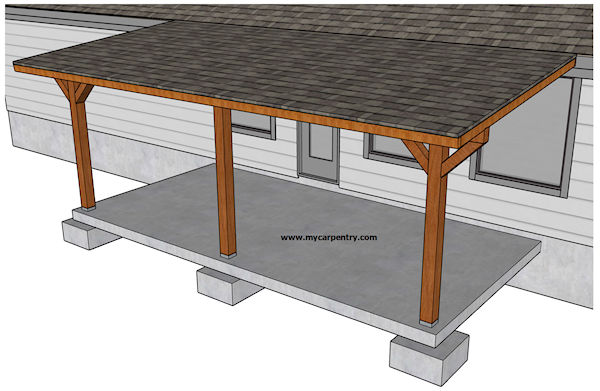
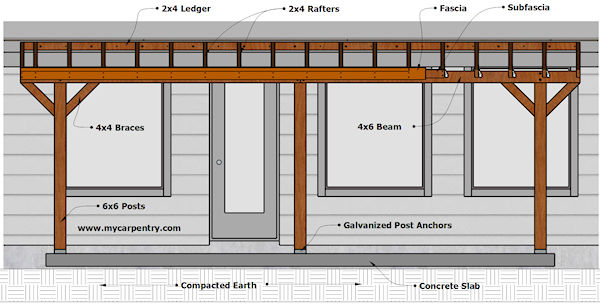
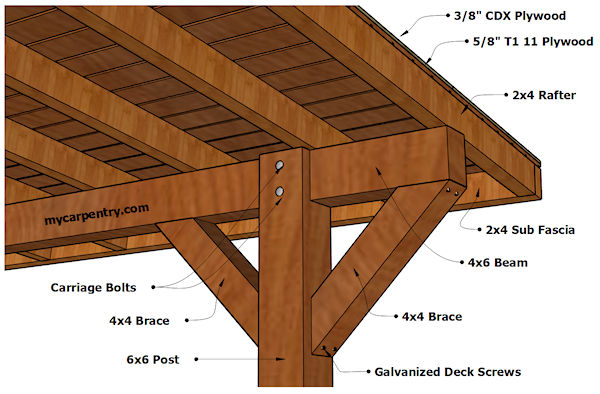
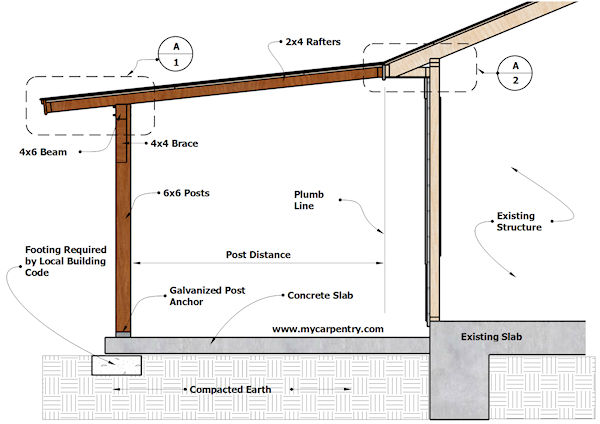
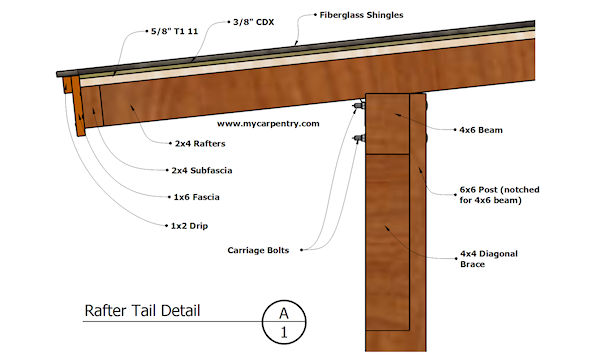
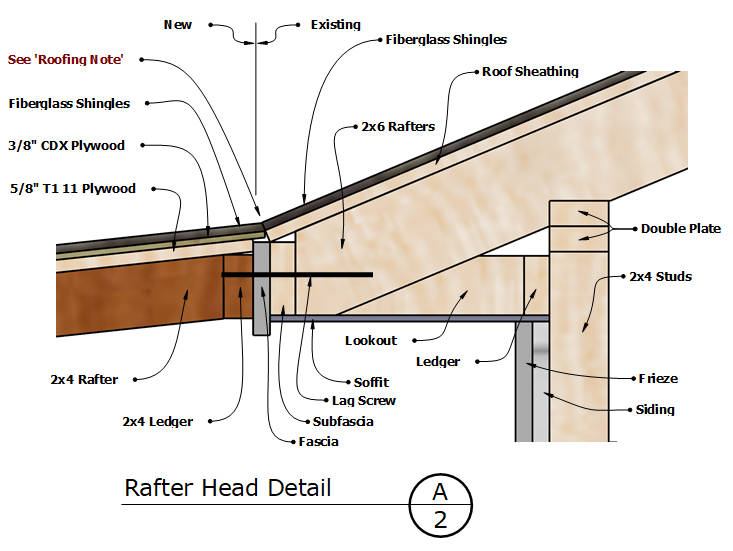
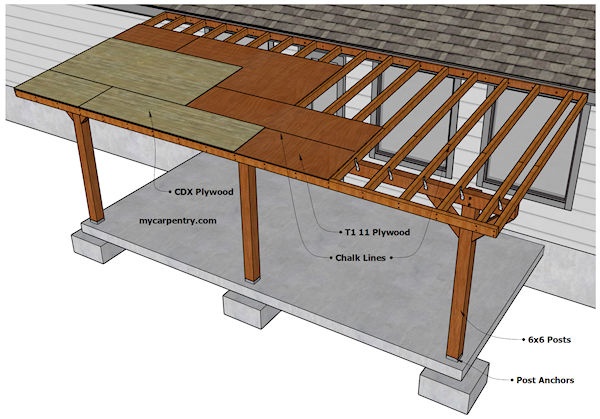
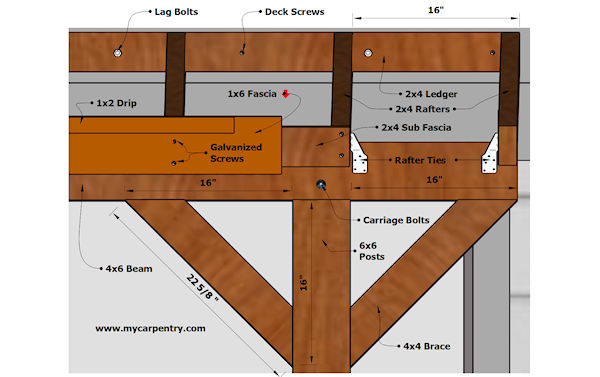
0 Response to "Best Way to Build Patio Attached to House"
Postar um comentário